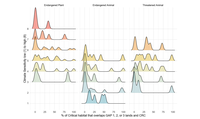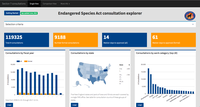
Designated critical habitats for U.S. imperiled species are not protected from climate and land-use change
Designation of critical habitat is an important conservation tool for species listed as threatened or endangered under the United States (U.S.) Endangered Species Act (ESA). While this is an important protective mechanism, lands designated as …Same law, diverging practice: Comparative analysis of Endangered Species Act consultations by two federal agencies
Evaluating how wildlife conservation laws are implemented is critical for safeguarding biodiversity. Two agencies, the U.S. Fish and Wildlife Service and National Marine Fisheries Service (FWS and NMFS; Services collectively), are responsible for …Recovery units under the Endangered Species Act could be used more widely
Recovering species is one of the main goals of the Endangered Species Act (ESA). In the face of limited budgets, diverse tools are needed to find efficient solutions. Recovery units may be one such tool -designated portions of a species range that …
Over $1.5 billion per year is needed to recover Endangered Species Act (ESA)-listed species
Recovering species listed as threatened or endangered under the Endangered Species Act (ESA) requires both significant and targeted investments to address the threats that caused the species’ decline and the need for ESA protection. Here we briefly …ESA Funding Infographic
The goals of the Endangered Species Act (ESA) are to prevent extinction and recover species, but these goals can only be met if the law is fully funded. Unfortunately, Congress has appropriated only a small portion of what scientists say is needed …